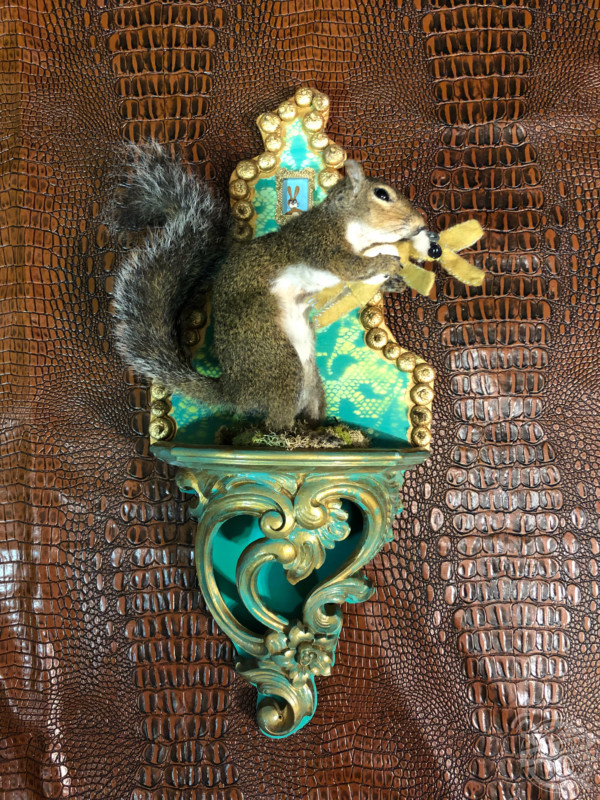By Alyce Collins
THIS BEAUTY SCHOOL DROPOUT who preferred to work on DEAD ANIMALS than live people became an ethical taxidermist, but she admits that people are still surprised to see a FEMALE taxidermist.
Owner of Bunny Lace Taxidermy, Meghan Cunningham (38) from Mississippi, USA, once worked in the beauty industry but after seeing a taxidermy tutorial she became more interested in creating looks for animals rather than people.

In 2012, while at beauty school, Meghan saw a tutorial for taxidermy, and she became intrigued by the art. However, Meghan wanted to find ways to ethically source her animals because she didn’t want animals to die for her hobby.
Having always had a creative background, the appeal of taxidermy lay in the sculpting opportunities. So, Meghan left beauty school and began sourcing dead wildlife to begin her new hobby.
The first dead animals Meghan found were roadkill, which she still uses frequently. Meghan’s home, which she shares with her husband Bryan, is located near a farm and any casualties are donated to her.
Unlike traditional taxidermists, Meghan doesn’t mount trophy animals, preferring to mount rabbits, squirrels, house cats, possums and bobcats. Meghan estimates that she has mounted over 700 animals, with each one taking approximately two-and-a-half weeks to complete.

Through her work, Meghan tries to honour the life of every animal she transforms and to bring happiness to it by creating colourful sets and costumes.
“After trying a variety of careers including teaching dance and owning a coffee and pastry food truck, I went to beauty school,” said Meghan.
“But I found myself more motivated to work on my hobby of taxidermy than working on live humans.
“I was working on a woman in a set and I found my mind wandering to my freezer containing dead squirrels. I literally could not wait to get home to begin the taxidermy process.
“That was the day I knew that I could not continue my current path and I had to dedicate myself to taxidermy, so I dropped out of beauty school and began my practice.
“My taxidermy career began by watching a video at a friend’s house. Being quite intrigued after watching the video, I began to figure out ways to find ethically sourced animals to reanimate in my own special way.
“I have sculpted, sewn and crafted things all of my life. Taxidermy was a perfect transition for all my different skill sets.
“The appeal for me was my sculptural background. I’ve always been able to make something with clay or wire into any shape I wanted, and I saw this as an opportunity to do taxidermy in a non-traditional way and give the animals a new life through my vision.

“I try to honour each animal that crosses my table. I don’t want them to just go in the bin, I want to give them a new life and bring happiness to people through my artwork.
“My first sources were roadkill and I still use a lot of roadkill in my work. Living in the countryside, I’m very fortunate to be near lots of farms where people raise animals for food and have casualties occurring naturally.
“Everyone knows that I’m a taxidermist who doesn’t mount traditional trophy animals and they call me to donate the animals when they pass of natural causes.
“The taxidermy process begins with skinning the animal, fleshing it, washing the animal and then preserving it with Borax. Then the hide must be stretched to a custom form.

“I don’t use commercial forms, or if I do, I radically modify them to be true to my artistic vision. I wouldn’t be happy with a bobcat unless it was roller-skating or flying through the air with antlers.
“After the mounting process is complete you must wait for the hide to dry, this can take up to three weeks, depending on the thickness of the fur, and the temperature. I then usually build sets and clothes to accentuate the piece.”
Meghan gave some of her early work to her friends, who then spread the message about her artwork, and she has since sold her pieces at markets and folk-art festivals.
Despite this, Meghan admits that ignorance is a large factor she has to deal with as many people are still surprised to see a female taxidermist.
“People’s reactions to my work are usually that of shock and awe. At first, they’re amazed that I created the piece and that it’s a real animal,” said Meghan.
“They’re also amazed that I created such a unique piece through my vision. I never use premade things; I hand-make all my pieces.
“I never have any conflict surrounding my work because I’m taking something that other people throw away and turn it into art, which brings people joy and happiness.
“The most difficult thing I deal with in my occupation is ignorance. Firstly, people are shocked that I, a woman, am responsible for the piece of taxidermy.
“Second, people are shocked that it’s an actual dead animal, and thirdly, people are shocked that I procured the animal in an ethical way.
“I only mount ethically sourced animals, including animals that were killed for food, roadkill or died of natural causes.
“I have mounted everything from roadkill possums, house cats, baby pygmy goats and bobcats. I recently mounted a foetal pig from a wild boar. I pride myself on mounting things other taxidermists would normally throw away.
“My favourite piece I’ve worked on would be my carousel of squirrels. I really enjoy what I do and I’m very fortunate to have created a niche for myself in the art world.
“I use taxidermy to step outside the norm and step into the realm of the fantastic. I love creating mythical creatures as well as anthropomorphic taxidermy.
“I hope that by sharing this information with the world I can teach more people about the art of ethical taxidermy.”
You can see more by visiting https://www.instagram.com/bunny_lane_/






